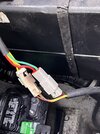You are using an out of date browser. It may not display this or other websites correctly.
You should upgrade or use an alternative browser.
You should upgrade or use an alternative browser.
Voltage regulator question
- Thread starter yakloin
- Start date
- Status
- Not open for further replies.
The boat is a 2005 seadoo challenger 180 if that helpsAnyone know what might of caused this to happen? I ordered a new voltage regulator, I’m just wondering what the wire is called I plug it into. Any advice would help. Thank you
Do you know what would cause it to melt?The 3 yellow wires carrying AC voltage come from the stator at the back of the motor,,,the red wire is is 12 plus volts DCto the battery,,and the green of course is ground.
ski-d00
Well-Known Member
This is a very common problem especially on the boats. The more current draw from the system, the more heat is built up at each connection because of the added resistance from a non perfect connection. You don't need a new stator. I would say yours is working very well. You just need to lower the resistance at the connection by making sure each connection is as good as it can be. I have even removed these connectors and hardwired directly to the stator to the voltage regulator in some extreme cases and also have soldered the crimp area on the terminals on others. You should also check the 3 wire connector to the rear of the ECU. I'm guessing that will be pretty toasty as well.
JC-SUPERJET
Active Member
Oops! Thought I was in the 2 Stroke Forum....
180 Watts of Power will eventually cook the Regulator/Rectifier.
The Rectifier charges the Battery.
Also make sure you have a good Battery and Clean Tight Connections. That Juice needs to go somewhere.
If the Battery is bad, it will resist the Charge coming from the Rectifier and bake it. Then a Domino effect of damage ensues.
I hope you ordered a High Quality Rectifier and not a cheap Chinese Knock-Off. Upgrading to a Heavy Duty 4-Stroke type Rectifier is ideal. See OSD Parts.
Most good Rectifiers have the Heat Fins running in the same direction of the Rectifier's Mounting Holes.
180 Watts of Power will eventually cook the Regulator/Rectifier.
The Rectifier charges the Battery.
Also make sure you have a good Battery and Clean Tight Connections. That Juice needs to go somewhere.
If the Battery is bad, it will resist the Charge coming from the Rectifier and bake it. Then a Domino effect of damage ensues.
I hope you ordered a High Quality Rectifier and not a cheap Chinese Knock-Off. Upgrading to a Heavy Duty 4-Stroke type Rectifier is ideal. See OSD Parts.
Most good Rectifiers have the Heat Fins running in the same direction of the Rectifier's Mounting Holes.
Last edited:
Can you send me the link please and thank youLike Ski-d00 said, resistance in the connector makes them run hot, and eventually discolors the connector or melts it. Had similar issue on my Challenger, bought new pins and connector, crimped then solder the new pins, no problems since. You can find them on Amazon,
I actually bought extra Deutsch Pins on Amazon, but I bought the pins with new connectors on ebay.
3 Pin Deutsch DT04-3P DT06-3S waterproof electrical connector kit | eBay
3 Pin Deutsch DT04-3P DT06-3S waterproof electrical connector kit | eBay
From the factory they are crimped only. I crimped and soldered and haven't had a problem since. The more solid the connection, the less chance of corrosion building up between the wire and connector. This is what causes the resistance and hence heat build up that melts the insulation and in some cases the connector. When I splice wires, I never use butt connectors, I solder and heat shrink the exposed wire - fix it once and don't have to deal with it again.
Premix
Active Member
I crimped and soldered and haven't had a problem since.
So did you crimp the contact to the wire, then melted the solder into the wire, or did you “tin” the wire first, then crimped the contact to it? Thanks!
- Status
- Not open for further replies.
Similar threads
- Replies
- 1
- Views
- 159
- Replies
- 1
- Views
- 541




